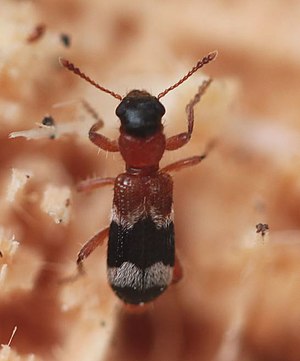Red-legged anthill beetle
| Red-legged anthill beetle | ||||||||||||
|---|---|---|---|---|---|---|---|---|---|---|---|---|

Red-legged beetle ( Thanasimus femoralis ) |
||||||||||||
| Systematics | ||||||||||||
|
||||||||||||
| Scientific name | ||||||||||||
| Thanasimus femoralis | ||||||||||||
| ( Zetterstedt , 1828) |
The red-legged beetle ( Thanasimus femoralis ) is a beetle from the family of the colored beetles (Cleridae).
features
The beetles are very similar to the related ants Thanasimus ( Thanasimus formicarius ), but are with 5.5-9.5 mm smaller and have a different color. The beetles have a black head and a relatively narrow red pronotum . The wing covers have two white cross bars. The back half of the elytra is otherwise black. The basal area of the wing covers is colored red-brown. In contrast to Thanasimus formicarius , this one borders directly on the first white transverse ligament, while Thanasimus formicarius has a narrow black transverse ligament in between. The metosternum and mesosternum are dark colored in Thanasimus femoralis , while in Thanasimus formicarius the entire underside of the abdomen and thorax is reddish brown. In contrast to Thanasimus formicarius, the antennae and legs are predominantly or completely red in color. The apical end of the femora may be dark in color.
distribution
The species is widespread in Scandinavia and Central Europe. In the east, the occurrence extends to the Caucasus and Kazakhstan . In recent years, finds have been reported in new regions in Europe, so it can be assumed that the species is about to increase its range. The countries affected are Belgium, Poland, Lithuania, Albania and Bulgaria. This could u. a. explain by transporting firewood and logs. In Germany, the species is considered common, but the beetles are rarely seen due to their special way of life.
Way of life
The red-legged beetle prefers larger pine and spruce forests as a habitat . There they are mainly in the treetops, where they hunt various bark beetles but also other insects. This also applies to the larvae of the red-legged beetle. The pine moth ( Dendrolimus pini ) is one of the prey animals . Due to the relatively few observations (phenology), a clear picture of the life cycle of the species cannot yet be made. It is assumed, however, that the species of beetle has a similar way of life as the spotted beetle and overwinters mainly in the larval stage.
Taxonomy
The following synonyms can be found in the literature :
- Clerus rufipes Brahm , 1797
- Clerus pectoralis foot , 1863
- Clerus substriatus Heyden , 1864
- Thanasimus pectoralis ( foot , 1863)
- Thanasimus rufipes ( Brahm , 1797)
- Thanasimus substriatus ( Heyden , 1864)
- Tillus pectoralis foot , 1863
Individual evidence
- ↑ a b c d e f g h Arno Thomaes, Alain Drumont, Nathalie Warzée, Jean-Claude Grégoire: Ecology and distribution of Thanasimus formicarius (Linnaeus, 1758) and the newly discovered Thanasimus femoralis (Zetterstedt, 1828) in Belgium (Coleoptera: Cleridae) . Bulletin de la Société royale belge d'Entomologie / Bulletin van de Koninklijke Belgische vereniging voor entomologie 153 (3); online: www.researchgate.net. January 2018. Retrieved November 23, 2019.
- ^ Hurka, K .: Beetles of the Czech and Slovak Republics, Kabourek, Zlin 2005, ISBN 80-86447-11-1 . Page 147.
- ↑ a b Thanasimus femoralis in Fauna Europaea. Retrieved November 23, 2019
- ↑ a b c Klaus Koch: Die Käfer Mitteleuropas - Ökologie - Volume 2 , Goecke & Evers Verlag, Krefeld, 1989, ISBN 3-87263-040-7 , p. 56
- ↑ Thanasimus femoralis . www.biolib.cz. Retrieved November 23, 2019.
Web links
- www.kerbtier.de
- Thanasimus femoralis at kaefer-der-welt.de
